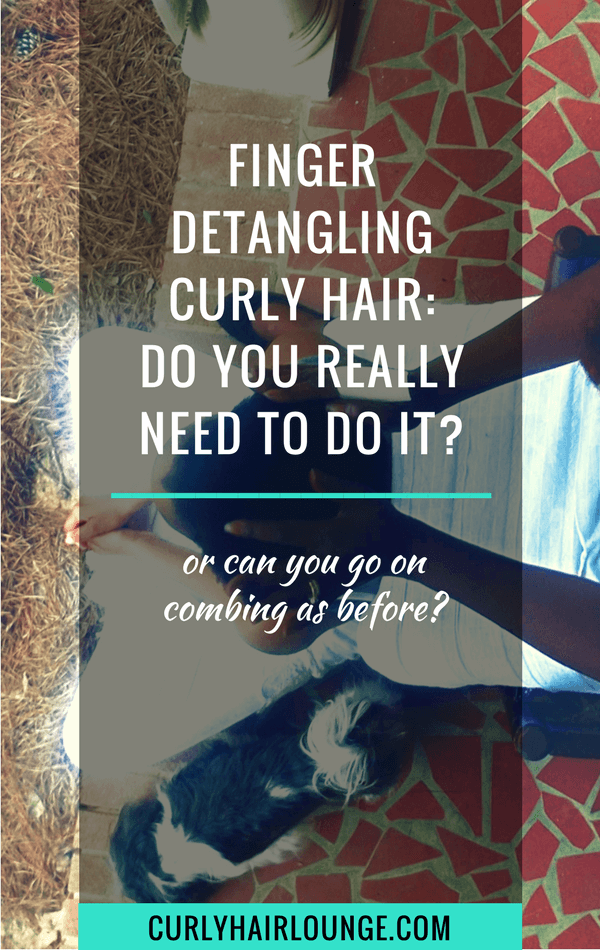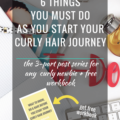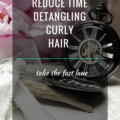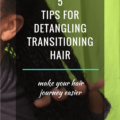As you enter your natural hair journey, the first time you hear of finger detangling as the safest and best way to comb your curly hair, your first thought can naturally be “Ain’t nobody got time for that!“. Trust me, I’ve been there. I too was sceptical about doing it until I finally gave in and wondered “Why in the hell didn’t I start this sooner?!“. Though many naturalistas may have had a similar experience to mine, many others won’t even consider working through their tangles without their favourite tool. As a newcomer into the whole natural hair thang, you may be left to wonder if you really need to be finger combing your curly hair.
If this is something you’re scratching your head thinking about and wondering what to do, I can only say that there’s nothing like trying it to discover your preferences.
Surprised to hear me say this?
Well, don’t be. Though I’m a big supporter of finger combing and have encouraged it many times before here on the blog, the truth is you have to do what feels comfortable to you and, most importantly, what is best for your hair.
Having said this, there are a couple of things I want you to consider when choosing the best detangling method for your hair.
Why is finger detangling the best option?
Though finger detangling may seem easier, quicker and better suited for people with straighter hair types as it tangles and knots up a lot less, it is exactly for this same reason that combing your hair using your fingers is best suited for curly hair.
Contrary to straight hair, curly hair swirls and clumps up facilitating the formation tangles and knots. When you use a comb or brush to work through your hair often times you are not aware of the force you are applying on it. This causes unnecessary breakage and pain.
When you finger comb you’re literally more sensitive to the amount of force you apply versus the “obstacles” you sense in your hair. You can gently untangle your hair, whereas if you push through with a comb or brush you can essentially be tightening up a knot even more and increasing hair breakage.
Additionally, because the natural oil that coats and protects the hair is unable to do so in curly hair making it dry, our hair is more susceptible and vulnerable to breakage. Compared to combs and brushes, your fingers are the best tool you can have to avoid an issue that is major to all natural girls out there, especially those transitioning to natural hair.
When is a comb or brush better?
Some people will swear to never touch a comb or brush again to detangle their hair, others won’t conceive tackling their mane without one of these tools and others, like me, have found a medium ground that works for them.
In my relaxed hair days, detangling took me maybe five minutes to do, always with the help of a comb. During my transition, I started out the same way but I soon learned it wasn’t working for my natural hair and I embraced finger detangling (boy, I was so happy to discover this, it saved me from tearful wash days, literally!).
Now that I’m natural, I use both methods – my fingers and a comb. Why? Because now that I’ve gotten rid of the weight of the relaxed hair my hair curls up more (there’s shrinkage for you 😉 ), which means more tangles I have to make sure I eradicate.
Though your fingers are the best choice to do the initial delicate and sometimes lengthy job, working through the most difficult tangles and knots, some may be left behind or missed. This is when a wide tooth comb is best used – to make sure you get rid of all the easy little tangles didn’t get to. If you leave any behind your next detangling session can become really difficult and time-consuming, not to mention the worsening of a problem that can sometimes have no other solution that the snip of a scissor.
Still, you may not find the need to use both methods and stick to just one. Do what makes your life easier. However, you should also consider if you intend to detangle on dry, damp or wet hair.
Dry, Damp or Wet Detangling?
This may sound like another head spinner for you, but it’s a very important thing to consider. This will be the difference between having scalp pain, hair breakage and hours detangling or seeing all this eliminated or reduced by less than half.
Let me explain why.
Dry hair may be more manageable than wet or damp hair but, because it is dry, it has less elasticity. Therefore, if you pull, comb or brush more briskly it can easily break and you’ll easily end up with a ball of hair on your hand.
Wet hair, on the other hand, is definitely more elastic so it won’t break as easily. You will be able to stretch it up to 30% of its length and not cause any breakage. However, because of this same feature, you can overdo it and snap your hair.
Additionally, have you considered your hair’s health? If you factor in damaged hair (relaxed, coloured, heat, sun or chlorine damaged hair) the breaking point will be much lower for both dry and wet hair when you comb (with fingers or a tool) with too much force.
Damp hair is a middle ground solution that will probably offer you more control as you detangle your hair. But there are other solutions you can go for when doing wet or dry detangling.
- Dry Detangling
- Oil pre-poo (before cleansing hair) – helps hair strands slide against each other facilitating detangling.
- Wet Detangling
- Oil + conditioner detangling as pre-poo solution
- Conditioner detangling as pre-proo or during washing process (ingredients in a conditioner close cuticle layers of the hair making it easier to detangle).
You can link here for more about what it is, tips and recipes about pre-poo. Me personally, although I always do an oil pre-poo before washing, I only detangle after I shampoo my hair when I apply my conditioner.
Best Tools
As I said here before, the best tool you can ever have for detangling your natural hair will be the cheapest (a good thing in this case ;)) and one you already have – your fingers. The next best options will be a wide tooth comb, preferably without any visible seam or with smooth seams to avoid snagging and pulling of hair. Ultimately, many have also found the Denman brush, Ouidad’s Double Detangler or the Tangle Teezer really helpful.






